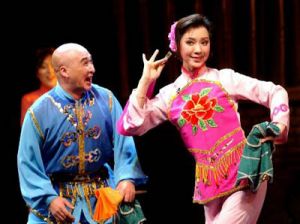Er'renzhuan
Everywhere in the entire northeast China, many people are fans of er'renzhuan (Two-person Song and Dance Duet), a traditional form of folk opera very much popular there.
As early as several hundreds years ago, with its flexible and vivid style, er'renzhuan was performed inside the huts of hunters, ginseng diggers and gold-miners, as well as in the yards of farmers.
In er'renzhuan, one actor and one actress would act out a number of characters, singing and dancing, on and off the stage. Though called er'renzhuan (which literally means "two person rotating"), very often more than two players are needed in a performance.
The performance is generally divided into three styles: danchutou (one-person performance), er'renzhuan (two-person duet) and lachangxi (short folk plays calling for more than two performers). In danchutou, there is only one player who acts the different characters in a changing and animated way, while in lachangxi it involves more than two people but with a young female actress and a male clown playing the leading role, and retains the lively unique flavor and performing style of er'renzhuan.
Over hundreds of years, er'renzhuan has acquired its own distinctive skills, commonly known as "four skills and one secret": singing, speaking, acting, dancing, and the unique skill of handkerchief or fan playing. In the hands of the performer, the handkerchief becomes a living being, sometimes resembling a rotating wheel or an instruction flag, and at other times flying high or falling slowly. The small fan is no mere prop, as it can change into different forms, attracting people's attention.
Er'renzhuan opera uses informal and candid language, as well as melodic local accents, to arouse the audience's emotions with the players' actions, words and performances. All the tunes and tones employed in the singing come across as warm, intimate and heartfelt.
The dialogue in er'renzhuan, called shuokou (speaking), is divided into different types, such as taozikou (set dialogues), gedakou (blurts) and zhuankou (witty dialogue). The local people enjoy the lively language, the smart and humorous dialogues and down-to-earth plots. The acting in er'renzhuan is also referred to as "doing," to fully energize the performances to attract people's attention and emotional response, a unique feature of the opera.
The dancing is very special, especially in skills of the wrists. The diverse wrist movements are truly dazzling. Besides the wrist skills, also very important are the shoulder skills, waist skills and various feet movements.
Er'renzhuan performance requires that "if two persons act the same character, the character must remain the same though the players are different," "if a player acts various characters, the characters must be different though there is only one player." No matter how complex the plot is, how many characters, how grand the scene, there are usually only two players in one play: one female, and one clown. They act out the old and young, male and female, on and off the stage. The changes of character are frequent but appear seamless and natural. The players must use their range of acting skills so that each character shows to the full his or her own spirit.
Originating from and spreading among the common folks, the er'renzhuan repertoire includes Fifth Watch of a Crescent Night, White Jasmine and Young Scholar Strolls in a Temple.
